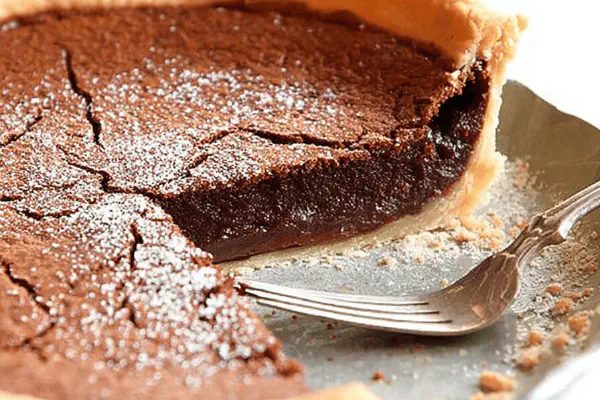Tangy Buttermilk Pie

By Emma
Certified Culinary Professional
Ingredients
- 1 pre-made pie shell or homemade chilled
- 8 tablespoons butter softened (swap half for browned butter for nuttiness)
- 3/4 cup granulated sugar (reduce by 10% if sensitive to sweetness)
- 2 tablespoons all-purpose flour
- 1/4 teaspoon kosher salt
- 3 large eggs at room temp
- 1 cup buttermilk (can replace 1/2 cup with canned coconut milk for lighter richness)
- 1 teaspoon pure vanilla extract
About the ingredients
Method
Preparation
- Oven to 320°F instead of 325—slower heat stops cracking crust edges. Keep pie shell in fridge while mixing ingredients, cold dough shrinks less during bake.
Mixing
- Butter and sugar on medium-high speed. Whip till fluffy, around 2-3 minutes. Watch texture, no grit. Too cold butter = lumpy mess; soften for best results. Add flour and salt. Beat briefly 20 seconds—just to combine, not develop gluten or stiff batter.
- Two eggs, one at a time with pause to fully blend, no rush. Third egg joins last. Overbeating eggs can cause curdling, so moderate speed, watch batter.
- Buttermilk and vanilla fold in last. Buttermilk's acidity cuts sweetness, makes filling tender, creamier texture. Coconut milk adds subtle tropical edge—test your crowd.
Baking
- Put pie shell on baking tray—catches drips, easier to move. Pour filling in gently, don’t shake or bubbles form, cause cracking.
- Bake 55-60 minutes. Center should jiggle slightly, not liquid. Knife coming out clean means custard set. Edges golden, no burning. If crust edges brown too fast, foil shield midway.
Cooling
- Remove carefully. Let cool on wire rack, no fridge before set or pie weeps moisture. Perfect slice: firm custard with wet shine on surface. Refrigerate after completely cool.
- Store covered for next day—flavors meld deeper.
Cooking tips
Chef's notes
- 💡 Lower oven temp to 320°F slows bake. Stops crust shrinking and cracking edges. Cold pie shell straight from fridge stays stable. Don’t rush mixing; butter must be soft but not melted for fluff. Sugar whipped till pale signals enough air in batter. Flour added briefly—don't overmix here or pie gets tough. Eggs folded gently one at a time, slow pace to avoid curdling. Pay attention to batter texture; thin but not watery.
- 💡 Folding in buttermilk last holds texture; acidity makes custard tender. Coconut milk swap boosts richness without heaviness. Test crowd tolerance first, tropical notes subtle but present. Pour filling gently—avoid shaking pie, air bubbles here create cracks while baking. Use a baking tray under shell for spills and easy movement. Shield crust edges midbake with foil if browning fast, protects color and texture, helps edge hold shape.
- 💡 Jiggle in center when baking is cue. Almost firm but slight wobble means custard set; knife clean at center confirms doneness. Overbake = dry, cracked top. Underbake = too soft, leaks juice. Cooling on wire rack is key; no fridge while warm or pie sweats. Let pie finish set at room temp before chilling. Refrigerate only fully cold; flavors meld better, texture firms up without moisture pooling under crust.
- 💡 Butter type impacts overall taste and seasoning; unsalted preferred for control, salted works if adjusting salt in batter. Chilling shell lowers shrinkage risk; wrap edges tight with foil if edges brown too soon. Flour balances filling; skip it, custard too loose, weep happens. Egg temp crucial—room temp blends better, cold eggs risk lumps. Vanilla quality changes final taste noticeably; real extract over artificial makes difference. Bake slow, patience wins here.
- 💡 Multiple fails happened with fast bake, cracked tops, runny center. Lower temp saves crust and filling. Careful mixing—no whipped eggs but not scrambled either. Timing crucial; knife test over timer only. Cooling steps not skip if slicing neat slices matter. Store covered after cold at least overnight to deepen flavor—makes slightly denser texture, less fragile. Slice with a sharp knife, clean cuts show good set custard.
Common questions
Why lower oven temp?
Slower bake stops crust cracking. Heat not too fierce lets edges firm first. Prevents shrink and breaks. Else fast heat causes cracks from dough tension. Also filling sets evenly inside.
Can I substitute coconut milk fully?
Works but changes texture quite a bit. More tropical richness, less tang. Full swap makes pie heavier, less custardy feel. Mixed half-half balances richness and tenderness. Experiment small batch before scaling.
What if pie cracks?
Usually overbake or oven too hot. Also shaking filling creates bubbles that pop during bake. Use foil on edges. Let pie cool on rack fully; cutting warm pie lifts cracks further. Repair not an option once baked.
How store leftovers?
Cover pie loosely with foil or plastic wrap. Keep refrigerated overnight best. Avoid stacking or tight wrap warm pie or moisture pools. Can freeze but texture softens. Reheat gently or serve cold.



